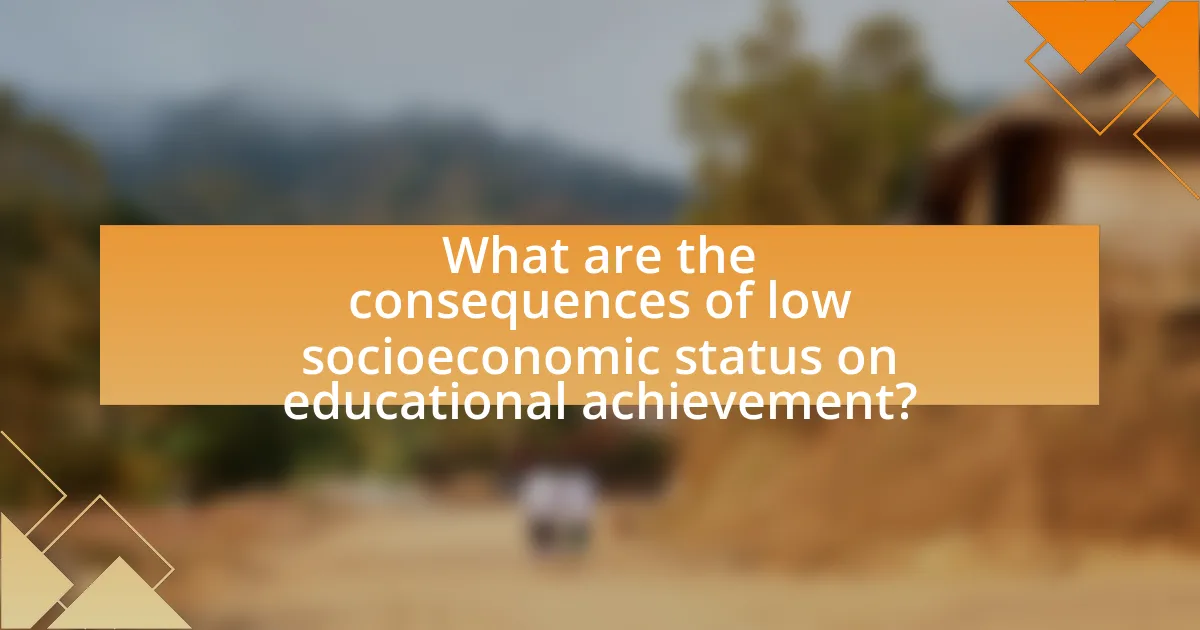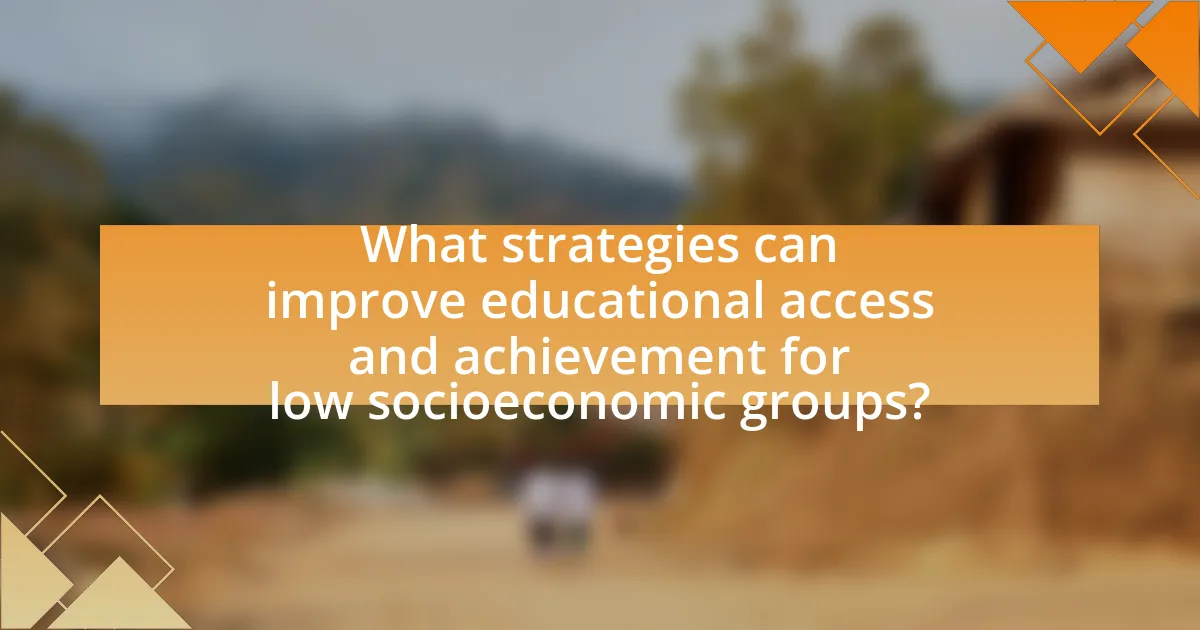The article examines the significant impact of socioeconomic status on educational access and achievement, highlighting how individuals from lower socioeconomic backgrounds encounter barriers such as limited financial resources, inadequate school facilities, and reduced access to extracurricular opportunities. It discusses key factors influencing educational outcomes, including family income, parental education levels, and access to resources, while also addressing the psychological effects of socioeconomic status on students. Furthermore, the article explores strategies for improving educational access for low-income groups, the role of community organizations, and practical steps families can take to support their children’s educational success. Overall, it underscores the critical relationship between socioeconomic factors and educational equity, emphasizing the need for targeted interventions to bridge the achievement gap.

What is the Impact of Socioeconomic Status on Educational Access and Achievement?
Socioeconomic status significantly impacts educational access and achievement, as individuals from lower socioeconomic backgrounds often face barriers such as limited financial resources, inadequate school facilities, and reduced access to extracurricular opportunities. Research indicates that students from low-income families are less likely to enroll in preschool programs, which can hinder their early development and readiness for school. According to the National Center for Education Statistics, students from high-income families score, on average, 25% higher on standardized tests compared to their low-income peers, highlighting the achievement gap linked to socioeconomic disparities. Furthermore, socioeconomic status influences parental involvement in education, with higher-income parents typically having more time and resources to engage with their children’s schooling, further contributing to differences in educational outcomes.
How does socioeconomic status influence educational opportunities?
Socioeconomic status significantly influences educational opportunities by determining access to resources such as quality schools, extracurricular activities, and educational support. Families with higher socioeconomic status can afford to live in neighborhoods with better-funded schools, which often have more experienced teachers and advanced coursework. Research from the National Center for Education Statistics indicates that students from low-income families are less likely to have access to advanced placement courses and extracurricular programs, which are crucial for college readiness. Additionally, socioeconomic status affects parental involvement in education; parents with higher education levels and financial stability are more likely to engage in their children’s schooling, further enhancing educational outcomes.
What are the key factors of socioeconomic status affecting education?
Key factors of socioeconomic status affecting education include family income, parental education levels, and access to resources. Family income directly influences the ability to afford educational materials, extracurricular activities, and quality schooling options. Research indicates that children from low-income families often attend underfunded schools, which can lead to lower academic achievement (National Center for Education Statistics, 2020). Parental education levels significantly impact children’s educational outcomes, as parents with higher education are more likely to engage in their children’s learning and provide academic support. Additionally, access to resources such as tutoring, technology, and safe learning environments is often limited for those in lower socioeconomic brackets, further hindering educational success.
How do these factors vary across different demographics?
Factors related to socioeconomic status significantly vary across different demographics, influencing educational access and achievement. For instance, students from low-income families often face barriers such as limited access to quality schools, fewer educational resources, and less parental support compared to their higher-income peers. According to the National Center for Education Statistics, students from low-income backgrounds are less likely to graduate high school and pursue higher education, with only 12% of low-income students earning a bachelor’s degree by age 24, compared to 54% of their higher-income counterparts. Additionally, racial and ethnic disparities exist, as minority students frequently attend underfunded schools, which exacerbates the achievement gap. These variations highlight the critical role that socioeconomic factors play in shaping educational outcomes across different demographic groups.
Why is educational access important for socioeconomic mobility?
Educational access is crucial for socioeconomic mobility because it provides individuals with the knowledge and skills necessary to improve their economic status. Access to quality education enables people to secure better job opportunities, which can lead to higher income levels and improved living conditions. According to the U.S. Bureau of Labor Statistics, individuals with a bachelor’s degree earn approximately 66% more than those with only a high school diploma, illustrating the direct correlation between education and income potential. Furthermore, educational access helps break the cycle of poverty by equipping disadvantaged groups with the tools to achieve upward mobility, thereby fostering a more equitable society.
What role does education play in breaking the cycle of poverty?
Education plays a crucial role in breaking the cycle of poverty by providing individuals with the skills and knowledge necessary to secure better employment opportunities. Access to quality education increases earning potential; for instance, individuals with a college degree earn, on average, 66% more than those with only a high school diploma, according to the U.S. Bureau of Labor Statistics. Furthermore, education fosters critical thinking and problem-solving skills, enabling individuals to navigate economic challenges more effectively. By improving educational access, particularly for low-income families, society can enhance social mobility and reduce income inequality, ultimately contributing to the alleviation of poverty.
How does access to quality education differ by socioeconomic status?
Access to quality education significantly differs by socioeconomic status, with individuals from lower socioeconomic backgrounds facing greater barriers. Research indicates that students from low-income families often attend underfunded schools, which typically have fewer resources, less experienced teachers, and lower overall academic performance. For instance, a report by the National Center for Education Statistics shows that schools in high-poverty areas receive about $1,000 less per student than those in affluent areas. This funding disparity leads to a lack of advanced coursework and extracurricular opportunities, further widening the educational gap. Consequently, students from higher socioeconomic backgrounds generally have better access to quality education, resulting in higher graduation rates and college enrollment.

What are the consequences of low socioeconomic status on educational achievement?
Low socioeconomic status significantly hinders educational achievement by limiting access to resources, quality schools, and support systems. Students from low-income families often face inadequate educational facilities, fewer extracurricular opportunities, and limited access to technology, which negatively impacts their learning outcomes. Research indicates that children from low socioeconomic backgrounds score lower on standardized tests and have higher dropout rates compared to their more affluent peers. For instance, a study by the National Center for Education Statistics found that students eligible for free or reduced-price lunch, a common indicator of low socioeconomic status, had lower average scores in reading and mathematics than those not eligible. This disparity illustrates the profound impact of socioeconomic factors on educational success.
How does socioeconomic status affect academic performance?
Socioeconomic status significantly affects academic performance by influencing access to resources, educational opportunities, and support systems. Students from higher socioeconomic backgrounds typically have access to better educational facilities, tutoring, and extracurricular activities, which enhance learning outcomes. Research indicates that children from low-income families often face challenges such as inadequate school funding, limited access to technology, and less parental involvement, all of which can hinder their academic success. For instance, a study published in the “Journal of Educational Psychology” by Sirin (2005) found that socioeconomic status accounts for a substantial portion of the variance in academic achievement, highlighting the direct correlation between economic resources and educational performance.
What specific challenges do students from low socioeconomic backgrounds face?
Students from low socioeconomic backgrounds face significant challenges that hinder their educational access and achievement. These challenges include limited access to quality educational resources, such as experienced teachers and advanced coursework, which can negatively impact academic performance. According to the National Center for Education Statistics, students from low-income families are less likely to have access to advanced placement courses and extracurricular activities that enhance learning opportunities. Additionally, financial instability often leads to higher levels of stress and distraction, affecting students’ focus and engagement in school. Research by the American Psychological Association indicates that socioeconomic stressors can impair cognitive function and academic motivation, further exacerbating educational disparities.
How do these challenges impact long-term educational outcomes?
Challenges related to socioeconomic status significantly hinder long-term educational outcomes by limiting access to resources, quality instruction, and supportive learning environments. Students from low socioeconomic backgrounds often face inadequate school facilities, fewer extracurricular opportunities, and limited access to technology, which can lead to lower academic performance and reduced graduation rates. Research indicates that children from disadvantaged backgrounds are less likely to complete higher education; for instance, a study by the National Center for Education Statistics found that only 11% of students from low-income families earn a bachelor’s degree by age 24, compared to 54% from high-income families. This disparity in educational attainment perpetuates cycles of poverty and limits future employment opportunities, further entrenching socioeconomic inequalities.
What are the psychological effects of socioeconomic status on students?
Socioeconomic status significantly influences the psychological well-being of students, often leading to increased stress, anxiety, and lower self-esteem. Students from lower socioeconomic backgrounds frequently experience feelings of inadequacy and hopelessness due to limited access to resources, which can hinder their academic performance and overall mental health. Research indicates that children in poverty are more likely to face mental health challenges; for instance, a study published in the Journal of Child Psychology and Psychiatry found that low socioeconomic status is associated with higher rates of depression and anxiety among adolescents. This correlation underscores the profound impact that socioeconomic factors have on the psychological development and educational outcomes of students.
How does socioeconomic status influence student motivation and engagement?
Socioeconomic status significantly influences student motivation and engagement by affecting access to resources, support systems, and educational opportunities. Students from higher socioeconomic backgrounds often have access to better educational resources, such as tutoring, extracurricular activities, and advanced coursework, which can enhance their motivation to learn and engage in school. Conversely, students from lower socioeconomic backgrounds may face challenges such as limited access to educational materials, less parental support, and higher levels of stress related to financial instability, which can diminish their motivation and engagement in academic activities. Research indicates that socioeconomic disparities can lead to differences in academic performance, with students from lower socioeconomic backgrounds often exhibiting lower levels of motivation and engagement due to these systemic barriers.
What support systems can mitigate these psychological effects?
Support systems that can mitigate psychological effects related to socioeconomic status include counseling services, mentorship programs, and community support networks. Counseling services provide professional mental health support, helping individuals cope with stress and anxiety stemming from financial instability. Mentorship programs connect students with role models who can offer guidance and encouragement, fostering resilience and motivation. Community support networks, such as local organizations and peer groups, create a sense of belonging and provide resources that can alleviate feelings of isolation and hopelessness. Research indicates that access to these support systems significantly improves mental well-being and academic performance among individuals from lower socioeconomic backgrounds.

What strategies can improve educational access and achievement for low socioeconomic groups?
Strategies that can improve educational access and achievement for low socioeconomic groups include increasing funding for schools in underserved areas, implementing mentorship programs, and providing access to technology and resources. Increased funding allows schools to hire qualified teachers and improve facilities, which directly impacts student learning outcomes. For example, a study by the National Center for Education Statistics found that schools with higher funding levels have better student performance metrics. Mentorship programs connect students with role models who can guide them academically and socially, fostering a supportive environment that encourages persistence and success. Additionally, providing access to technology, such as computers and the internet, enables students to engage with educational materials and resources that are essential for modern learning, as evidenced by research from the Pew Research Center, which indicates that technology access correlates with improved academic performance.
How can policy changes enhance educational equity?
Policy changes can enhance educational equity by implementing targeted funding and resource allocation to underprivileged schools. For instance, the Every Student Succeeds Act (ESSA) in the United States mandates that states address disparities in educational resources, ensuring that schools serving low-income students receive adequate support. Research shows that equitable funding leads to improved student outcomes, as evidenced by a study from the National Bureau of Economic Research, which found that increased funding in low-income districts significantly boosts student achievement. By prioritizing policies that focus on equitable distribution of resources, educational equity can be effectively enhanced.
What specific policies have proven effective in improving access?
Specific policies that have proven effective in improving access to education include targeted funding for low-income schools, universal pre-K programs, and scholarship initiatives for underprivileged students. Targeted funding, such as Title I in the United States, allocates resources to schools serving high percentages of low-income students, resulting in improved educational outcomes. Universal pre-K programs have been shown to enhance early childhood education access, leading to better long-term academic performance. Additionally, scholarship initiatives, like the Pell Grant program, provide financial assistance to low-income students, increasing their ability to attend college and complete their degrees. These policies collectively address barriers related to socioeconomic status, facilitating greater educational access and achievement.
How can schools implement programs to support disadvantaged students?
Schools can implement programs to support disadvantaged students by establishing targeted academic support initiatives, such as tutoring and mentoring programs. These initiatives can be designed to address specific learning gaps and provide personalized assistance, which has been shown to improve academic performance among students from low socioeconomic backgrounds. For instance, a study by the National Center for Education Statistics found that students who participated in tutoring programs showed significant improvements in math and reading scores compared to their peers who did not receive such support. Additionally, schools can create partnerships with community organizations to provide resources like after-school programs, access to technology, and mental health services, which are crucial for the holistic development of disadvantaged students.
What role do community organizations play in supporting educational access?
Community organizations play a crucial role in supporting educational access by providing resources, advocacy, and programs that address barriers faced by underserved populations. These organizations often offer tutoring, mentorship, and after-school programs that enhance learning opportunities for students from low socioeconomic backgrounds. For instance, a report by the National Center for Education Statistics indicates that community-based programs significantly improve academic performance and school attendance among disadvantaged youth. Additionally, community organizations advocate for policy changes that promote equitable funding and access to quality education, further reinforcing their impact on educational access.
How can partnerships between schools and communities enhance educational outcomes?
Partnerships between schools and communities enhance educational outcomes by fostering collaboration that addresses the diverse needs of students. These partnerships can provide resources such as mentorship programs, after-school activities, and access to community services, which support student learning and engagement. For instance, a study by the Harvard Family Research Project found that schools with strong community partnerships saw improved student attendance and academic performance, as these collaborations often lead to increased parental involvement and support systems. Additionally, community resources can help bridge gaps in socioeconomic disparities, ensuring that all students have access to necessary educational tools and opportunities.
What best practices can be adopted by community organizations to support students?
Community organizations can adopt several best practices to support students effectively. First, they should establish partnerships with local schools to create mentorship programs that connect students with role models, enhancing their academic and social skills. Research indicates that mentorship can lead to improved academic performance and increased school engagement. Additionally, organizations should provide access to resources such as tutoring, after-school programs, and college readiness workshops, which have been shown to bridge educational gaps for students from low socioeconomic backgrounds. Furthermore, offering financial literacy programs can empower families to make informed decisions about education-related expenses, thereby reducing barriers to access. By implementing these practices, community organizations can significantly contribute to the educational success of students facing socioeconomic challenges.
What practical steps can families take to support educational achievement?
Families can support educational achievement by creating a structured and supportive home environment that prioritizes learning. This includes establishing a consistent routine for homework and study time, which research shows enhances academic performance by providing students with a clear framework for their educational activities. Additionally, families can engage in open communication about school and learning, fostering a culture of curiosity and motivation. Studies indicate that parental involvement, such as attending school events and communicating with teachers, positively correlates with student success. Furthermore, providing access to educational resources, such as books and technology, can bridge gaps in learning opportunities, particularly for families from lower socioeconomic backgrounds.



